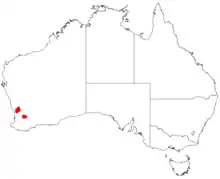| Acacia anarthros | |
|---|---|
| Scientific classification | |
| Kingdom: | Plantae |
| Clade: | Tracheophytes |
| Clade: | Angiosperms |
| Clade: | Eudicots |
| Clade: | Rosids |
| Order: | Fabales |
| Family: | Fabaceae |
| Subfamily: | Caesalpinioideae |
| Clade: | Mimosoid clade |
| Genus: | Acacia |
| Species: | A. anarthros |
| Binomial name | |
| Acacia anarthros | |
 | |
| Occurrence data from AVH | |
Acacia anarthros is a shrub of the genus Acacia and the subgenus Pulchellae that is endemic to an area of south western Australia.
Description
The spinose shrub typically grows to a height of 0.1 to 0.5 metres (0.3 to 1.6 ft)[1] and have hairy and flexuose branchlets with spiny stipules that are 3 to 7 mm (0.12 to 0.28 in) in length. The stout, straight to recurved primary leaf axis is 0.5 to 2 cm (0.20 to 0.79 in) in length and have one pair of pinnae that are 2 to 5 mm (0.079 to 0.197 in) long and have two to three pairs of green and glabrous pinnules that are 4 to 10 mm (0.16 to 0.39 in) in length and 0.5 to 1.5 mm (0.020 to 0.059 in).[2] It blooms from June to September and produces yellow flowers.[1] The simple inflorescences occur singly in the axils and have spherical flower-heads that contain 14 to 16 golden coloured flowers. The shortly villous and crustaceous seed pods that form after flowering have a narrowly oblong shape with a length up to 6 cm (2.4 in) and with a width of 5 to 8 mm (0.20 to 0.31 in). The broadly elliptic to circular shaped seeds have a length of 3 to 4 mm (0.12 to 0.16 in) and are microscopically wrinkly.[2]
Taxonomy
The species was first formally described by the botanist Bruce Maslin in 1979 as a part of the work Studies in the genus Acacia (Mimosaceae) - 9 Additional notes on the Series Pulchellae Benth. as published in the journal Nuytsia. It was reclassified by Leslie Pedley in 2003 as Racosperma anarthon then transferred back to genus Acacia in 2006. The only other synonym is Acacia drewiana subsp. pungens.[3]
Distribution
It is native to a small area in the Wheatbelt region of Western Australia where it is commonly situated on hillslopes growing in gravelly lateritic soils.[1] The limited range is around New Norcia as a part of heathland or open Eucalyptus wandoo woodland or Corymbia calophylla woodland communities.[2]
See also
References
- 1 2 3 "Acacia anarthros". FloraBase. Western Australian Government Department of Biodiversity, Conservation and Attractions.
- 1 2 3 "Acacia anarthros Maslin". Wattle - Acacias of Australia. Lucid Central. Retrieved 1 February 2021.
- ↑ "Acacia anarthros Maslin". Atlas of Living Australia. Global Biodiversity Information Facility. Retrieved 1 February 2021.
